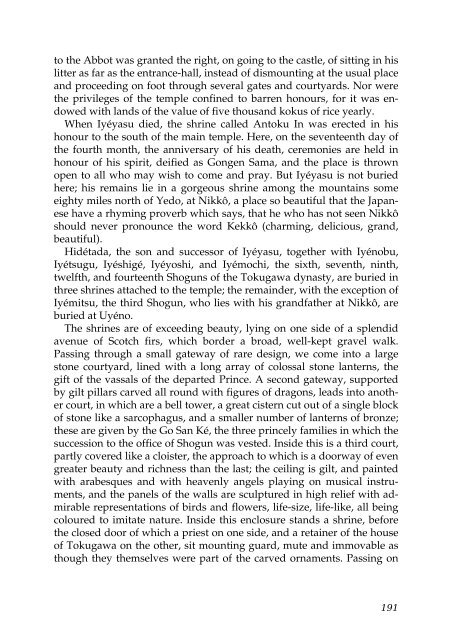Create successful ePaper yourself
Turn your PDF publications into a flip-book with our unique Google optimized e-Paper software.
to the Abbot was granted the right, on going to the castle, <strong>of</strong> sitting in his<br />
litter as far as the entrance-hall, instead <strong>of</strong> dismounting at the usual place<br />
and proceeding on foot through several gates and courtyards. Nor were<br />
the privileges <strong>of</strong> the temple confined to barren honours, for it was endowed<br />
with lands <strong>of</strong> the value <strong>of</strong> five thousand kokus <strong>of</strong> rice yearly.<br />
When Iyéyasu died, the shrine called Antoku In was erected in his<br />
honour to the south <strong>of</strong> the main temple. Here, on the seventeenth day <strong>of</strong><br />
the fourth month, the anniversary <strong>of</strong> his death, ceremonies are held in<br />
honour <strong>of</strong> his spirit, deified as Gongen Sama, and the place is thrown<br />
open to all who may wish to come and pray. But Iyéyasu is not buried<br />
here; his remains lie in a gorgeous shrine among the mountains some<br />
eighty miles north <strong>of</strong> Yedo, at Nikkô, a place so beautiful that the <strong>Japan</strong>ese<br />
have a rhyming proverb which says, that he who has not seen Nikkô<br />
should never pronounce the word Kekkô (charming, delicious, grand,<br />
beautiful).<br />
Hidétada, the son and successor <strong>of</strong> Iyéyasu, together with Iyénobu,<br />
Iyétsugu, Iyéshigé, Iyéyoshi, and Iyémochi, the sixth, seventh, ninth,<br />
twelfth, and fourteenth Shoguns <strong>of</strong> the Tokugawa dynasty, are buried in<br />
three shrines attached to the temple; the remainder, with the exception <strong>of</strong><br />
Iyémitsu, the third Shogun, who lies with his grandfather at Nikkô, are<br />
buried at Uyéno.<br />
The shrines are <strong>of</strong> exceeding beauty, lying on one side <strong>of</strong> a splendid<br />
avenue <strong>of</strong> Scotch firs, which border a broad, well-kept gravel walk.<br />
Passing through a small gateway <strong>of</strong> rare design, we come into a large<br />
stone courtyard, lined with a long array <strong>of</strong> colossal stone lanterns, the<br />
gift <strong>of</strong> the vassals <strong>of</strong> the departed Prince. A second gateway, supported<br />
by gilt pillars carved all round with figures <strong>of</strong> dragons, leads into another<br />
court, in which are a bell tower, a great cistern cut out <strong>of</strong> a single block<br />
<strong>of</strong> stone like a sarcophagus, and a smaller number <strong>of</strong> lanterns <strong>of</strong> bronze;<br />
these are given by the Go San Ké, the three princely families in which the<br />
succession to the <strong>of</strong>fice <strong>of</strong> Shogun was vested. Inside this is a third court,<br />
partly covered like a cloister, the approach to which is a doorway <strong>of</strong> even<br />
greater beauty and richness than the last; the ceiling is gilt, and painted<br />
with arabesques and with heavenly angels playing on musical instruments,<br />
and the panels <strong>of</strong> the walls are sculptured in high relief with admirable<br />
representations <strong>of</strong> birds and flowers, life-size, life-like, all being<br />
coloured to imitate nature. Inside this enclosure stands a shrine, before<br />
the closed door <strong>of</strong> which a priest on one side, and a retainer <strong>of</strong> the house<br />
<strong>of</strong> Tokugawa on the other, sit mounting guard, mute and immovable as<br />
though they themselves were part <strong>of</strong> the carved ornaments. Passing on<br />
191



